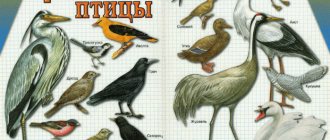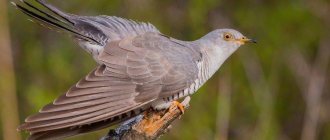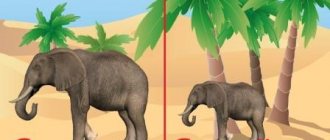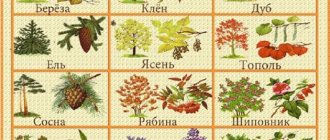MAGAZINE Preschooler.RF
THEMED GAME “MY CITY”One of the most important and striking traits of preschoolers is curiosity. Children constantly ask questions and want answers right away. If adults cannot or do not want to explain to children what interests them, their curiosity disappears. Therefore, the only option for introducing children to the world around them is to learn how to answer any questions children may have.
In early preschool age, all the child’s activities are subordinated to one leading need - knowledge of the world around him and himself in it. The main means of satisfying this need still continues to be the sensory (sensual) development of reality through sensations, sensory perceptions, and visual representations. But at this age the thresholds of sensations begin to decrease. This is compensated by an increase in visual acuity and accuracy in distinguishing colors, development of hearing, and accuracy in estimating the weight of objects.
The most characteristic actions are those that allow the child to examine objects, highlight their most typical properties - to separate and combine sensations, giving them the characteristics of sensory standards, generally accepted patterns of perception. Such activity lays the foundation for the transition to a higher stage of development - from visual-effective to imaginative thinking. Rhythm and clarity become the most important conditions for the development of normal perception and comprehension of what is perceived.
It is very important during this period to teach children to name their hometown (village). Encourage them to talk about where they walked on weekends (in a park, square, children's playground, in the country). Pay attention to buildings and remember the streets along which children walk from home to kindergarten, what attractions there are in their hometown, what rivers or even seas are nearby.
To get acquainted with the city, to expand knowledge about the world around us, and to develop communication skills, I offer the game “My City” .
"MY CITY"
Goal: Expanding children's knowledge about the world around them, developing children's communication skills. Forming an idea of classification based on characteristics.
Age: 3-8 years
Number of players: group of children 10-12 people
Necessary equipment: “city” , with marked streets. Sets of geometric shapes (circle, square, triangle, rectangle), primary colors. A set of rectangles with the name of administrative buildings: school, kindergarten, pharmacy, post office, hospital, cafe, store, etc.
Game description: At the beginning of the game, the presenter reads a poem for finger gymnastics “My City” .
I love walking around the city! (They walk with their fingers on their knees) I like to watch, (Turns the head left and right)
I love counting! (clench - unclench their fists) Streets - once! (Bend fingers one at a time)
Area – two! Park - three! And four - I live in an apartment! Five - I'm walking in the park again!
Six - I’ll go to Belaya and look at the water! Seven – “Nalmes” , Palace of Culture, Beautiful and huge,
And it is located in the center! Eight - New Year's tree! Nine - I came across the Great War Monument...
Ten is our cinema! I will go around all of Maykop! (They walk with their fingers on their knees) I love the city very much!
(Clench and unclench their fists)
Children remember and name administrative buildings and stick them in random order on the playing field. Then they place the house figures according to the names of the streets. For example: on VESENNYA (the color with which spring is associated) there can be houses of various shapes, but only green. On the street "MORSKOY" - blue (light blue). And on the street of “MULTI-COLORED SQUARES” there are only squares, but of different colors, etc.
When the city is built, you can proceed to the next stage of the game. Each participant chooses a “house” where he “lives” and gives it a number (you can write it on a figure). A preliminary conversation is held “Where do I live?” . Children name their street and house or apartment number. Then the adult starts the game: “Katya needs to go to the store. What is the best way for her to get through? Children “pave” the way to the desired building, while naming which streets they need to go through and past which buildings. Every child should be a leader. That. children explore the city, learn to navigate the area, and expand their knowledge about aspects of public life.
Play is the most progressive method of teaching preschoolers. It is through play that a child’s abilities such as intelligence, resourcefulness, the ability to think logically, compare and remember are more easily formed. Play makes the learning process less tedious and much more effective.
| Next > |
Speech therapist's living room
| Teacher-speech therapist Noskova Anna Evgenievna |
| |
| Teacher-speech therapist Elena Teymurazovna Krivenok |
| |
| Speech therapist Khoroneko Lyubov Anatolyenva |
| |
| Speech therapist Natalya Vladimirovna Prudkaya |
“News” from Anna Evgenievna
When a child is passionate about a game, the learning process is easier and more fun, especially if it is a computer game!
When working with children, we use the interactive speech therapy program “Games for Tigers”. With its help, we implement a systematic approach to the correction of speech development disorders. Exciting games with Tiger Cub increase children's motivation for speech therapy classes.
“News” from Elena Teymurazovna
The neuropsychological approach in the correctional work of specialists in the modern world occupies a leading position. It has been proven that exercises to stimulate the cerebellum, carried out before and during correctional measures, significantly increase their effectiveness!
In our classes we use the Siberian board, which helps solve the following problems in speech therapy work:
✅ starting and disinhibiting speech,
✅ automation of sounds,
✅ development of memory, attention, thinking,
✅ development of visual and motor reactions.
“News” from Anna Evgenievna
For more successful speech correction, automation and differentiation of delivered sounds, we use a board balancer . The close relationship between speech and movement allows the use of powerful compensatory mechanisms in children with developmental problems. Speech therapists and speech pathologists know that developing speech through movement brings positive results. By making certain movements, the child more clearly and correctly pronounces those syllables and words that he was unable to pronounce before.
The kids don’t notice that they are learning this way, they are just interested in trying something new and participating in exciting activities!
“News” from Elena Teymurazovna
The use of health-saving technologies is an integral part of the correction process. With the children of the middle group, we actively use Su-Jok therapy techniques as a massage of the muscles of the face and neck, for the development of fine motor skills, as well as for the purpose of general strengthening of the body.
“News” from Elena Teymurazovna
Children from the compensatory middle group continue to learn the basics of literacy. We have moved on to the stage of merging letters. To make this process even more interesting, we started playing: we laid out large letters, built a bridge between them from wooden sticks, took a tractor and started READING!!!
“News” from Elena Teymurazovna
We all like melodic, smooth and beautiful speech. For its formation, correct speech breathing is necessary, which we develop in classes with a speech therapist teacher. It is difficult for middle-aged children. Their respiratory muscles are still poorly developed. To make classes more interesting, we use playful, non-traditional techniques to develop a targeted, strong air stream. The kids really enjoy participating in TRACK RACES, creating a STORM IN A GLASS and playing FOOTBALL.
“News” from Anna Evgenievna
This week, the children of the compensatory group studied the lexical topic: Space. During a lesson with a speech therapist, we played with a “Spaceship” construction set. The boys and girls assembled the Space Station with pleasure and great interest and launched the Rocket from the cosmodrome. The space station was equipped with modern technology, computers, a table with a map of the solar system, a crane and fuel tanks.
“News” from Elena Teymurazovna
This school year, the children began to learn the basics of literacy. Before the New Year, we became acquainted with the sounds A; AND; ABOUT; U. The guys learned that we hear and pronounce sounds, that some sounds can be sung and such sounds are called VOWELS. After the New Year we moved on to studying LETTERS. Getting to know the first letter...
Quiz for children of the preparatory group of kindergarten. My city
Quiz for children 6-7 years old “My country.
My land. My city. My street" Purpose: Testing and activating children's knowledge and independent judgments about the country, native land and city. Objectives: • consolidate children's knowledge about our country, native land and city; • systematize children's knowledge about the symbols of the state: flag, coat of arms, anthem. • expand children's horizons; learn to answer questions depending on the content, using an accurate, expressive vocabulary; • to cultivate in children patriotic feelings, respect for all nationalities, love and respect for Russia. Materials and equipment: - laptop, multimedia projector, multimedia presentation; - images of parts of the house (30 pieces), envelopes with cut parts of sayings and proverbs about the Motherland, an envelope with parts of the Russian flag, an envelope with different images of the coat of arms of Russia, sound fragments of anthems, images of cultural symbols of Russia (matryoshka, Dymkovo toy, accordion), 9 scarves, folk instruments (spoons, metallophones, whistles), 3 album sheets of paper, 3 packs of felt-tip pens. Musical material used in the game “Pilots”: Idea, selection of music, mix - Kholodnaya I.V.
“Kangaroo dot, ru” by Zhanna Kolmagorova “Song about penguins” lyrics by A. Gorokhov, music by V. Kuprevich “Turtle” Music by A. Varlamov. Words by R. Panina “Dolphins” music. A. Varlamov “Merry monkeys” Y. Seliverstov “Good mood” lyrics. Natalya Ososhnik, music Vitaly Ososhnik Preparatory work: implementation of a child-adult project (with the participation of parents) - the books “Streets of my city”, “Professions of my parents”; exhibitions in the groups “Folk Crafts of the Urals”, “Treasures of the Urals” (exhibition of stones), “Sights of the City of Serov”; exhibition of books by writers and poets of the city of Serov; reading tales by P.P. Bazhov, exhibition of drawings and creative works “My City”, acquaintance with national customs (holiday “Svyatki”). Progress of activities
To the music of the song “My Russia” (G. Struve), children enter the hall and sit down at tables in subgroups.
The leading ball is large, there is a country on it, a city in it, and houses in it. The house is on one street, inconspicuous, small. This house, country, land - This is my Motherland! Presenter Today we have gathered, guys, to tell each other what we have learned about our homeland, our region, our city. You have to answer 10 questions and complete 10 tasks. You are divided into groups. Each group's responses will be scored. For each correct answer and correctly completed task, the team receives a part of the house, from which we will later make up a city. The better and more correct your answers are, the higher and more beautiful your houses will be. Who wants to build the tallest and most beautiful house? (children's answers)
Host Of course, you all want this. Then let's get to work! Attention, this is the first question of our quiz. 1. What is the name of the country in which we live? (Russia) Assignment to teams: Make up sayings and proverbs about our Motherland from parts (adults work in teams and read parts of proverbs to children). Team 1 - Beloved homeland, like a dear mother. Take care of your native land like your beloved mother. Team 2 – On someone else’s side, even spring is not beautiful. If friendship is great, the Motherland will be strong. Team 3 – A man without a homeland is like a nightingale without a song. The Motherland is your mother, know how to stand up for her. Leader Teams that correctly complete the task receive the first floor of the house. Presenter Attention, this is the second question of our quiz. 2. Name the state symbols of Russia (Coat of Arms, flag, anthem) Practical task: 1 team - collect the flag of Russia 2 team - determine in which fragment the Russian anthem sounds 3 team - Game “Find the differences” (different images of the coat of arms of Russia). Russia has a majestic double-headed eagle on its coat of arms, so that He could look to the west and east at once. He is strong, wise and proud. He is Russia's free spirit. (V. Stepanov) Presenter Teams that correctly complete the task receive the second floor of the house. Presenter Attention, this is the third question of our quiz. You discuss the answers as a team, one of the participants comes out and pronounces it. 3. Who is the head of the Russian state? (President) One of the team members is invited. Participants voice their teams' answers. Demonstration of photos by V.V. Putin on a presentation slide. Leader Teams that correctly complete the task receive the third floor of the house. Presenter Attention, this is the fourth question of our quiz. 4. Every country has a main city - the capital. What is the name of the capital of our homeland? (The capital of Russia is Moscow.)
Practical task: explain the meaning of expressions. The participants are conferring. One of the team members comes out and voices the team's answer. Team 1 - Why do they say “Moscow is the heart of Russia”? Team 2 - How can you understand the words: “They say it in Moscow, but they listen all over the country?” Team 3 - How can you understand the words: “She is the head of all cities, the capital of the Motherland is Moscow.” Leader Teams that correctly complete the task receive the fourth floor of the house. Presenter Attention, this is the fifth question of our quiz. Rus' has long been famous for its craftsmen. Child The stone-cutting craftsmen are famous, the Keepers of the magic fire, the steel and iron minters - Russia is a famous family. 5. “Who will draw and name the symbol of Russia more accurately?” Each team lines up. Teachers show each of their teams an image for 20 seconds. and remove it. Children sit down at the tables. On a sheet of paper, they take turns sketching what they managed to remember, then pass the sheet to another team member. Upon completion of the work, one team member comes out and demonstrates the resulting image and names the symbol of Russia. Leader Teams that correctly complete the task receive the fifth floor of the house. Presenter Attention, this is the sixth question of our quiz. Among the expanses of our great Motherland there is a corner where you live, where is your home, your native land. And wherever you are, wherever you go, you will always remember your native place, your home, your parents and friends. 6. What is the name of our native land? (Ural) Brave and skillful people lived in the Urals. After a hard day at work we played various musical instruments. Our ancestors knew how to work and relax with soul. Child Sonorous, carved, painted spoons From dawn to dawn the spooners play for us. And we are brave guys, skilled in all matters. We'll take the instruments and start the orchestra.
Assignment to the team: Listen to a sound fragment and play it on folk instruments. It is determined whose team will perform the melody more accurately and amicably. Leader Teams that correctly complete the task receive the sixth floor of the house. Presenter Attention, this is the seventh question of our quiz. 7. What were the names of the first inhabitants of the Urals? (Khanty and Mansi)
The Khanty and Mansi lived in tents. Game “Who can build a tent faster” (children use large scarves to build a tent, which team is faster)
Leader Teams that correctly complete the task receive the seventh floor of the house. Presenter Attention, this is the eighth question of our quiz. 8. Now we live in beautiful cities, in cozy houses. Whose name does our city bear? (pilot Anatoly Konstantinovich Serov)
Child He lifts a metal bird into the clouds. Our air border is reliable and strong. Presenter What do you think pilots should be like? Children speak out (strong, resilient, dexterous) Presenter Let's see if you can show courage and dexterity. Game "Airplane". Rules of the game. Children are divided into groups of 3 people. Each group is a squad of pilots. Every child is an airplane. Airplanes are in hangars. Hangars are located in any way: in a circle, in a line, in a column, etc. Each pilot must remember the location of his hangar in order to return exactly to it. At the signal, the pilots fly: arms to the sides, movement in any direction. Condition: do not bend your arms (considered a broken wing). If you encounter another plane, you can “plan”: lean to the right, left, forward, but do not bend your arms. At the signal, the pilots return to the hangars.
The game takes place with sound accompaniment.
Children listen to the announcer and perform the suggested actions: 1. “Pilots, to the airfield!”
Children sit down 2. “Let’s start the engines!” Children sitting (a prerequisite for alternating motor activity and rest) make a “winder” with bent arms. 3. “Take flight!” Children pretend to fly an airplane (fly) 4. “Attention, landing!” Children squat down. 5. Next, imitative movements of the animals of those countries and continents where the planes arrive are performed. Presenter We return to our city. Attention, landing! The children take their places at the tables. Leader Teams that successfully complete the task receive the eighth floor of the house. Presenter Attention, this is the ninth question of our quiz. 9. Game “Guess what I wished for” Images of various sights of the city of Serov are shown to the children. The presenter makes a wish for one of them. Children must guess what landmark he wished for by asking any questions except a direct question about the name. A set of images for team 1: - the city administration building - an anniversary stone for the city’s centenary. A set of images for team 2: - the building of the metallurgists’ palace of culture - “The Wishing Stone” at the library named after. D.N. Mamin-Sibiryak Set of images for team 3: - Temple of the Transfiguration of the Lord - Memorial "Eternal Flame" Leader Teams that successfully complete the task receive the ninth floor of the house. Presenter Attention, this is the tenth and final question of our quiz. 10. There are many streets and squares in our city. On what street is our kindergarten located? Why is this street called Green? (children's answers)
Leader Teams that successfully complete the task receive the tenth floor of the house. Presenter Our children, together with their parents, prepared the book “Streets of Our City”. Demonstration of the book and children's stories about the streets. Leading. - You guys are great, you know a lot about your Motherland, you love it and its nature, you respect your family and friends, you know your land. I invite each team to create their own house from the floors they receive. Approach with invention, imagination. Create your own unusual home. Leading. What wonderful houses you have turned out to be. Let's look at each other's houses. Children walk in a circle, looking at the houses of other teams.
Leading. Guys, look, there are empty windows in our houses. Let's light some lights in them. - Evaluate your work. Use felt-tip pens to color the windows of the house like this: • green light - he didn’t make a single mistake, he always knew the answer, he’s happy with himself; • yellow light – made an inaccuracy, did not always know the answer; • red light - I still need to learn a lot, I need to try and success will come. Houses with lit lights are located on a stylized street. Leading. Let's stand in a reflective circle. Look at each other, give a smile to your neighbor. Thank everyone for their work. Let's, guys, take care of kindness, Let's take care of beauty, guys, Let's dare, let's create, Give each other a smile of knowledge! The sun walks in circles and gives its light to the children. And with light comes Friendship - sunny greetings. The children follow the leader out of the hall to the music “We Are Together” (Words and music by Ksenia Sitnik).
We recommend watching:
Quiz with answers on fairy tales for children of the preparatory group Interesting questions on fairy tales for children of the preparatory group Quiz with answers on the topic: Summer for children of the preparatory group Quiz with answers for children 5-7 years old. Inhabitants of Africa
Similar articles:
Quiz on the topic “Trees and shrubs” for children 5-7 years old
Quiz on the topic “Wild Animals” for children 5-7 years old
Quiz on the theme “Birds” for children 6-7 years old
Quiz with answers “Andersen's Fairy Tales” for preschoolers
Quiz with answers “Fairy Tales of Charles Perrault” for preschoolers







